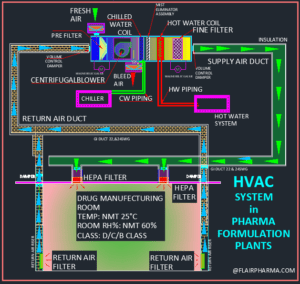Deep Pleated Hepa Filter and mini-pleated HEPA filters are two types of high-efficiency air filters commonly used in various industries. While both types of filters serve the same purpose of removing small particles from the air, there are some key differences between them. Here are some of the main differences between deep-pleated and mini-pleated HEPA filters.
Design and Construction:
Deep-pleated HEPA filters are made from sheets of pleated filter media to increase the filter’s surface area and capacity. The pleats are separated by corrugated aluminum separators that maintain the spacing between the pleats and provide rigidity to the filter. On the other hand, mini-pleated HEPA filters are made from sheets of filter media that are folded and pleated in a zig-zag pattern, creating a compact filter with a high surface area. Mini pleated HEPA filters use hot-melt adhesive to separate the wrinkles, eliminating the need for separators.
Efficiency:
Both deep-pleated and mini-pleated HEPA filters have high-efficiency ratings, but mini-pleated HEPA filters are generally considered to be more efficient. Mini pleated HEPA filters are designed to have a higher surface area, which allows for more particles to be captured. Additionally, the hot-melt adhesive used to separate the pleats in mini-pleated filters creates a seamless barrier that reduces the chance of air bypassing the filter media.
Airflow Resistance:
Another critical difference between deep-pleated and mini-pleated HEPA filters is their resistance to airflow. Because of their larger size and corrugated separators, deep-pleated HEPA filters tend to have higher airflow resistance than mini-pleated filters. This can lead to higher energy costs and increased wear and tear on HVAC systems. Mini pleated HEPA filters, on the other hand, have lower airflow resistance due to their compact design and absence of separators.
Application:
Deep pleated HEPA filters are commonly used in applications where high-temperature resistance is required, such as in industrial ovens and dryers, as well as in cleanrooms for pharmaceutical and biotech industries. Mini pleated HEPA filters are often used in applications where space is limited, such as in HVAC systems, clean benches, and portable air purifiers.
Maintenance:
Deep-pleated HEPA filters are easier to maintain than mini-pleated filters. They can be easily removed from their housing and replaced, and are less likely to become damaged during the replacement process. Mini pleated filters, on the other hand, require more specialized handling due to their compact size and delicate construction.

In summary, while both deep-pleated and mini-pleated HEPA filters have high-efficiency ratings and are used to remove small particles from the air, they have different designs and are better suited for different applications. Deep-pleated HEPA filters are better for high-temperature applications, while mini-pleated HEPA filters are more efficient and better suited for limited-space applications.
Technical details of Deep Pleated HEPA Filter and Mini Pleated HEPA Filter
| Technical Details | Deep Pleated HEPA Filter | Mini Pleated HEPA Filter |
| Filter Media | Superfine fiberglass, separated with paper or aluminum foil | Superfine fiberglass, separated with hot-melt adhesive |
| Frame Material | Aluminum and max 80-degree heat resistant | Superfine fiberglass, separated with hot-melt adhesive |
| Separator Type | Heat-resistant material such as wood, aluminum alloy, steel, or stainless steel | Hot-melt adhesive separator |
| Depth | 6-12 inches | 2-4 inches |
| Efficiency | 99.97% @ 0.3 μm | 99.99% @ 0.3 μm |
| Airflow Rate | Low to medium | High |
| Pressure Drop | High | Low |
| Resistance to Humidity | High | Low |
| Temperature Range | Up to 250°F | Up to 80°C |
| Applications | Hospitals and Healthcare Facilities, Pharmaceutical Manufacturing, Semiconductor Manufacturing, Aerospace and Defense, Electronics and Computer Manufacturing, Cleanrooms and Controlled Environments, Food Processing and Packaging, Automotive Manufacturing, Nuclear and Radiological Facilities, Paint and Coatings Manufacturing | High cleanliness required equipment and terminal outlets |
Media
| Feature | Deep Pleated HEPA Filter | Mini Pleated HEPA Filter |
|---|---|---|
| Media | Fine fiberglass | Fine fiberglass |
| Media Separation | Aluminum foil or paper | Hot-melt adhesive |
| Pleat Depth | Deep pleats | Shallower pleats |
| Surface Area | Lower per unit of filter area | Higher per unit of filter area |
| Pressure Drop | Higher | Lower |
| Efficiency | High | High |
| Application | Industrial | Commercial, residential, and space-constrained environments |
As seen in the table, the primary difference between deep-pleated HEPA filters and mini-pleated HEPA filters is in their media construction. Deep-pleated HEPA filters use a fine fiberglass media that is separated by aluminum foil or paper and is folded into deep pleats. In contrast, mini-pleated HEPA filters use a similar fiberglass media but with shallower pleats and are separated by hot-melt adhesive.
The difference in pleat depth affects the surface area of the filter. Mini-pleated HEPA filters have a higher surface area per unit of filter area compared to deep-pleated HEPA filters. This results in lower pressure drop, which is a measure of resistance to airflow. Both filters have high efficiency, meaning they can capture particles as small as 0.3 microns with at least 99.97% efficiency.
The application of deep pleated HEPA filters is mostly in industrial settings where larger, thicker filters are required. On the other hand, mini pleated HEPA filters are commonly used in commercial and residential settings, as well as in applications where space is at a premium.
You may also read about the SOP of the LAF


